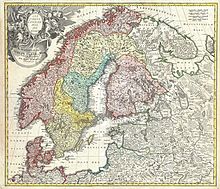Expedition to Lapland



The expedition to Lapland, the northernmost region in Sweden, by Carl Linnaeus between May and October 1732 was an important part of his scientific career.
Linnaeus departed from
Background
In April 1732, Linnaeus was awarded a grant from the
Uppsala to Umeå
Linnaeus began his expedition from
First inland incursion
From Umeå, Linnaeus headed towards
Umeå to Luleå and second inland incursion
After returning to Umeå, he travelled further north along the coast of the
Luleå to Tornio, third inland incursion and return to Uppsala
Linnaeus then continued his travel along the coast to Tornio (Torneå in Swedish), from which he made his third and final inland incursion, along the Torne River as far as Vittangi. He spent some time in the Tornio area; in Kalix he received instructions in assaying. In the middle of September he began his return journey. Travelling via Kemi, he followed the Finnish coastline to Turku (Åbo in Swedish), where he sailed via Åland, arriving in Sweden in Grisslehamn and then finally home to Uppsala.[12]
Results
He returned from his six-month-long, over 2,000 kilometres (1,200 mi) expedition on 10 October, having gathered and observed many plants, birds and rocks.[13][14][15] Although Lapland was a region with limited biodiversity, Linnaeus described about a hundred previously undescribed plants. The details of his discoveries became the basis of his book Flora Lapponica.[16][17]
Linnaeus's account of the journey, Iter Lapponicum[18] was translated into English by James Edward Smith and published in 1811 as Lachesis Lapponica: A Tour in Lapland. Some of Linnaeus' original illustrations:
-
The mythological Andromeda and the plant he named for her.
-
A Sami carrying his boat.
Notes
- missionaries, his coat would be removed and he would be held down while the main artery in his arm was opened; he was then left to bleed until he had promised to come to heel – a procedure, says Linnaeus, that was 'often successful'."
- Sápmi (area).
- ^ See also this map Archived 2016-03-03 at the Wayback Machine showing Linnaeus' travels during his Lapland expedition via [1] from Linné, Carl von. 1991. Lappländische Reise und andere Schriften. Leipzig.
References
- ^ Blunt (2001) Pages 41–65
- ^ Frodin, David 2002. Guide to Standard Floras of the World, 2nd ed. Cambridge University Press: Cambridge. p. 27.
- ^ Anderson (1997) Pages 42–43
- ^ Blunt (2001) Page 38
- ^ a b Blunt (2001) Pages 42–43
- ^ Anderson (1997) Pages 43–44
- ^ Anderson (1997) Page 46
- ^ Blunt (2001) Pages 47–51
- ^ Blunt (2001) Pages 45–47
- ^ Anderson (1997) Pages 50–51
- ^ Blunt (2001) Pages 55–56
- ^ Blunt (2001) Pages 64–65
- ^ Blunt (2001) Pages 63–65
- ^ Blunt (2004) Pages 39–42
- ^ Broberg (2006) Page 29
- ^ Quammen, David (June 2007). "The Name Giver". National Geographic: 2. Archived from the original on April 15, 2010. Retrieved 2010-04-03.
- ^ Stöver (1974) Pages 38–39
- ^ "Carl von Linnés Ungdomsskrifter, Andra serien". 1889.
Bibliography
- Anderson, Margaret J. (1997). Carl Linnaeus: father of classification. United States: Enslow Publishers. ISBN 978-0-89490-786-9.
- Blunt, Wilfrid (2001). Linnaeus: the compleat naturalist. London: Frances Lincoln. ]
- Blunt, Wilfrid (2004). Linnaeus: the compleat naturalist. London: Frances Lincoln. ISBN 0-7112-2362-9.
- ISBN 91-520-0912-2.
- Linnaeus, Carl (1811). Lachesis Lapponica: A Tour in Lapland. Tr. James Edward Smith. London: White and Cochrane.
- Stöver, Dietrich Johann Heinrich (1794). Joseph Trapp (ed.). The life of Sir Charles Linnæus. London: Library of Congress. ISBN 0-19-850122-6.
External links
- A Tour in Lapland by Carolus Linnaeus Unabridged, fully illustrated edition at the Ex-Classics Project. Can be read online or downloaded in various formats.
- Lachesis Lapponica, or a TOUR IN LAPLAND volume 1 presented by James Edward Smith of the Linnean Society of London and preserved at the Internet Archive
- Lachesis Lapponica, or a TOUR IN LAPLAND volume 2 presented by James Edward Smith of the Linnean Society of London and preserved at the Internet Archive


